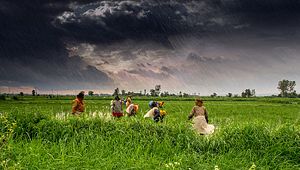India’s trade-distorting farm subsidies are already far in excess of the limits agreed to in their World Trade Organization commitments. Now India wants WTO members to look the other way while it increases subsidies further. With global commodity prices weakening, those subsidies are likely to damage farmers in other countries, tempt tit-for-tat reactions from their governments, and threaten the rules-based international trading system. To staunch that threat, agricultural trading nations should bring a WTO dispute-settlement case seeking an end to India’s abusive practices.
India purchases basic crops from farmers at artificially high prices, and then sells a portion in 500,000 “fair price” stores to some 800 million poor people at low prices. An estimated 40 percent of the food never reaches its intended consumers. Much of it escapes from government control due to graft and corruption. The remainder of the wastage is due to inadequate storage and transportation facilities. The Food Corporation of India (FCI), a government agency, held 68.7 million metric tons (MMT) of grain in storage on July 1. Three MMT of that supply (equivalent to the annual wheat consumption of the Philippines) were kept in sacks on the ground covered only with plastic sheeting. Government-induced loss of food seems particularly cruel in a country where many people remain hungry. Yet India continues to exacerbate this inefficient system.
India’s farm subsidies harm its own economy. Farmers are incentivized to devote more land and water to subsidized crops (wheat, rice, sugar, etc.) desired by the government. This leads to less production and higher prices for other items (fruits, vegetables, etc.) that consumers also want to buy. India justifies these policies under the guise of achieving “food security” by encouraging domestic production of basic crops. The same excuse is given to justify commodity prices being held above world levels through the use of high tariffs and other import restraints. Most economists would agree, however, that security of supply is hurt rather than helped by import restrictions. A failure of India’s annual monsoon rains can lead to drought and reduced crop output. By relying so heavily on its own production, India is more vulnerable to food supply shocks than would be the case if its agricultural economy was integrated fully into the large and resilient global market.
WTO rules on agricultural subsidies came into effect in 1995 at the conclusion of the Uruguay Round negotiations. WTO members strongly supported limits on trade-distorting subsidies because the global marketplace had been wracked by rampant subsidy competition among wealthy nations, most prominently the European Community and the United States. Farmers in non-subsidizing countries suffered with low prices. The Agreement on Agriculture addressed this problem by placing limits on trade-distorting subsidies, while allowing a wide range of non-distorting government services and payments to be provided to farmers. It also permitted governments to spend as much as they wish to provide food to low-income people. An insightful (and conservative) 2011 study by DTB Associates calculated that India was then exceeding its allowed domestic support levels by a minimum of $37 billion. That much subsidization can do serious damage to world commodity markets and the farmers who depend on them.
India is now proposing that the WTO should reverse position and endorse an increase in distorting farm subsidies. Keep in mind that India is not a small player in global agriculture. It not only boasts the world’s second largest population, it also has the second largest area of arable land. Recently India ignored the WTO’s prohibition on new export subsidies and began to use them on sugar, thus undercutting sugar exporters such as Thailand and Brazil. If India won’t follow the rules to which it has agreed, other countries are likely soon to follow suit.
Last December, when India was resisting conclusion of the WTO Trade Facilitation Agreement (TFA), it received assurances that there would be a “peace clause” under which other countries would agree not to challenge its agricultural subsidy programs. When India finally blew up the TFA in July, the peace clause was blown up along with it. That’s just as well, because the WTO Agreement on Agriculture is genuinely worth defending. WTO members should do India and the world a favor and file a dispute-settlement case against India’s agricultural policies. The goal would be to encourage India to shift toward using farm support measures that the Agreement on Agriculture specifically allows. Such an outcome would be far more constructive than pushing the global agricultural economy back into a subsidy war in which the clear losers would be taxpayers, farmers in other developing countries, and the rules-based international trading system.
Dan Pearson is a Senior Fellow for Trade Policy Studies at the Cato Institute. Before Cato, he served 10 years on the U.S. International Trade Commission.

































